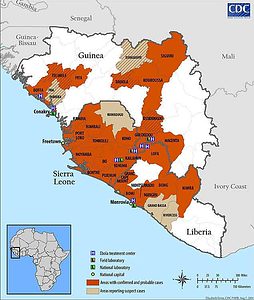
The fast-moving news about the West Africa Ebola outbreak – the largest and longest ever recorded for the disease – may have overshadowed news of an important technical advance. An online data tool signaled a “mystery hemorrhagic fever” in forested areas of southeastern nine days before the World Health Organization announced the epidemic. In disease control, that’s a life-saving edge.
The tool is HealthMap and it scoured thousands of social media sites, local news sources, government websites, and physicians’ social networks for indicators of emerging or spreading disease.
Early detection makes a big difference in how epidemics are contained. Health response teams have to know the disease they’re dealing with, how fast it’s moving, and where, if they’re going to position the right people and supplies to deal with it. Speed is even more essential in the developing world, where dangerous diseases are likely to emerge and where public health infrastructure may be weak.
The latest Ebola outbreak sprang up in Guinea in March. It then spread to Sierra Leone, Liberia, and Nigeria: places that weren’t familiar with its symptoms. The public and many under-prepared health care workers responded with confusion. By the time doctors realized that they were dealing with the Ebola virus, patients had already been to hospitals and clinics that lacked the equipment and trained personnel needed to contain the disease.

And so, it spread . . . along with eyewitness reports, social media threads, and blog posts from health care workers. By March 10, HealthMap began to pick up on these Internet nuggets and fit them together. On March 19, its algorithm triggered an alert, one of the earliest warnings of the Ebola threat.
Why social media?
Conventional case reporting is the foundation of modern disease surveillance, but collecting the right data can be time-consuming. Of all the methods used to track disease indicators, however, social media is one of the fastest, which is probably why it’s been tried before as an early harbinger of disease outbreaks.
Twitter was tried during the 2009 swine flu outbreak, but results were noisy because Twitter users generated too many different types of conversations. Google Flu Trends, launched in 2010, used aggregated Google search data and seemed to work better.
In 2012, Sickweather was launched as one of the first consumer-focused tools for tracking disease through social media chatter. The program scanned social networks for mentions of 24 different symptoms. That same year, the US Health and Human Services sponsored a contest to develop a Twitter-based disease detection system. Results are still being evaluated.
Social media have an important advantage as a data source. The WHO and similar organizations must maintain good relationships with the countries where they operate. Because some countries consider the release of any information concerning disease outbreaks as a state secret, public health programs can require a delicate balance of science and politics. Social media resources, however, are publicly available so the algorithms that use them can bypass many government roadblocks. And because most social media data sources are public, tools like HealthMap are available to users for free. Everyone can access HealthMap.
Detailed digging
So, what was the specific contribution of HealthMap? Yes – its algorithm.
The HealthMap edge was its ability to sift out small bits of information and fit them into patterns as soon as the first reports surfaced. HealthMap data processing includes filters that weed out irrelevant data and classify what remains until it converges on identification. In many ways, the algorithm functions like a semantic web, allowing fast, automatic searches for germane content from the large data sets.
In the eight years since the site was first introduced, HealthMap has evolved into an interactive tool used by millions of people worldwide. Variants of the algorithm are being used to monitor:
- Dengue Fever
- Pharmacological drug effects
- Zoonotic diseases
The 2014 Ebola outbreak will challenge health care systems internationally, and the human cost in deaths, fear, and disrupted communities won’t be known for months. The crisis has shown, however, that social media may offer a potent resource to detect and contain future outbreaks.






